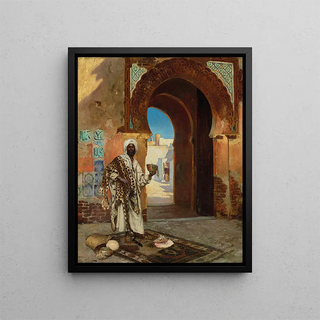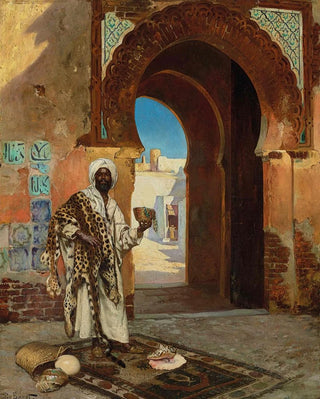Art print | The Shell Merchant - Rudolf Ernst


View from behind

Frame (optional)
In the rich and vibrant universe of oriental painting, "The Shell Merchant" by Rudolf Ernst stands as an iconic artwork, captivating the eye and mind of anyone who lingers on it. This canvas, which evokes lively markets and vibrant scenes of life, transports us directly to the heart of a fascinating culture, where the sea and its treasures are both a source of life and inspiration. Through this art print, the viewer is invited to immerse themselves in a world where every detail tells a story, every color evokes an emotion, and every form brings us closer to a past rich in exchanges and discoveries.
Style and uniqueness of the work
Rudolf Ernst, master of orientalism painting, succeeds in capturing the very essence of his subject with remarkable precision and delicacy. "The Shell Merchant" is distinguished by its bold use of light, which dances on the surfaces of the shells, creating shimmering reflections that irresistibly draw the eye. The characters, dressed in traditional costumes, are depicted with such liveliness that they almost seem to come to life on the canvas. The composition, carefully balanced, invites exploration of every corner of the scene, revealing subtle details that testify to meticulous observation of reality. This painting is not just a simple representation; it becomes an open window to a rich and complex culture, where art and daily life intertwine.
The artist and his influence
Rudolf Ernst, born in 1854 in Vienna, established himself as one of the most influential artists of his time, thanks to his unique talent for translating the beauty of the Orient onto canvas. His journey led him to travel through several countries, notably Morocco and Egypt, where he drew inspiration from landscapes, colors, and local traditions. The impact of his work is felt not only through the technical quality of his achievements but also through the way he managed to awaken interest in Orientalism within the Western world. The scenes he depicts, often imbued with a certain melancholy, testify to a deep fascination with different cultures.

Matte finish

View from behind

Frame (optional)
In the rich and vibrant universe of oriental painting, "The Shell Merchant" by Rudolf Ernst stands as an iconic artwork, captivating the eye and mind of anyone who lingers on it. This canvas, which evokes lively markets and vibrant scenes of life, transports us directly to the heart of a fascinating culture, where the sea and its treasures are both a source of life and inspiration. Through this art print, the viewer is invited to immerse themselves in a world where every detail tells a story, every color evokes an emotion, and every form brings us closer to a past rich in exchanges and discoveries.
Style and uniqueness of the work
Rudolf Ernst, master of orientalism painting, succeeds in capturing the very essence of his subject with remarkable precision and delicacy. "The Shell Merchant" is distinguished by its bold use of light, which dances on the surfaces of the shells, creating shimmering reflections that irresistibly draw the eye. The characters, dressed in traditional costumes, are depicted with such liveliness that they almost seem to come to life on the canvas. The composition, carefully balanced, invites exploration of every corner of the scene, revealing subtle details that testify to meticulous observation of reality. This painting is not just a simple representation; it becomes an open window to a rich and complex culture, where art and daily life intertwine.
The artist and his influence
Rudolf Ernst, born in 1854 in Vienna, established himself as one of the most influential artists of his time, thanks to his unique talent for translating the beauty of the Orient onto canvas. His journey led him to travel through several countries, notably Morocco and Egypt, where he drew inspiration from landscapes, colors, and local traditions. The impact of his work is felt not only through the technical quality of his achievements but also through the way he managed to awaken interest in Orientalism within the Western world. The scenes he depicts, often imbued with a certain melancholy, testify to a deep fascination with different cultures.






